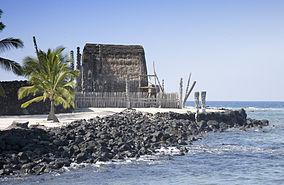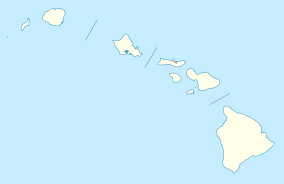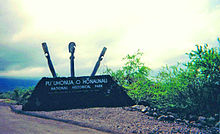- Puʻuhonua o Hōnaunau National Historical Park
-
Puʻuhonua o Hōnaunau National Historical Park IUCN Category V (Protected Landscape/Seascape)
Reconstructed Hale o KeaweLocation Hawaii County, Hawaii, USA Nearest city Holualoa, Hawaiʻi Coordinates 19°25′19″N 155°54′37″W / 19.42194°N 155.91028°WCoordinates: 19°25′19″N 155°54′37″W / 19.42194°N 155.91028°W Area 420 acres (1.7 km2) Established July 26, 1955 Visitors 476,237 (in 2005) Governing body National Park Service Puʻuhonua o Hōnaunau National Historical Park is a United States National Historical Park located on the west coast of the island of Hawaiʻi in the U.S. state of Hawaiʻi. The historical park preserves the site where, up until the early 19th century, Hawaiians who broke a kapu (one of the ancient laws) could avoid certain death by fleeing to this place of refuge or puʻuhonua. The offender would be absolved by a priest and freed to leave. Defeated warriors and non-combatants could also find refuge here during times of battle. The grounds just outside the Great Wall that encloses the puʻuhonua were home to several generations of powerful chiefs.
Contents
The park
The 420 acre (1.7 km2) site was originally established in 1955 as City of Refuge National Historical Park and was renamed on November 10, 1978. In 2000 the name was changed by the Hawaiian National Park Language Correction Act of 2000 observing the Hawaiian spelling.[1] It includes the puʻuhonua and a complex of archeological sites including: temple platforms, royal fishponds, sledding tracks, and some coastal village sites. The Hale o Keawe temple and several thatched structures have been reconstructed.
Hale O Keawe heiau
The park contains a reconstruction of the Hale O Keawe heiau, which was originally built by a Kona chief named Kanuha. After the death of Keawe, a great chief of Kona in the mid 16th century, his bones were entombed within the Heiau. The nobility (ali'i) of Kona continued to be buried here for 250 years. The last person buried here was a son of Kamehameha I in 1818.
It was believed that additional protection to the place of refuge was received from the mana in the bones of the chiefs. it survived several years after other temples were destroyed. It was looted by Lord George Byron (cousin of the distinguished English poet) in 1825.[2] In 1829, High Chiefess Kapiʻolani removed the remaining bones and hid them in the Pali Kapu O Keōua cliffs above nearby Kealakekua Bay. She then ordered this last temple to be destroyed. The bones were later moved to the Royal Mausoleum of Hawaii in 1858.[3]
References
- ^ Hawaiian National Park Language Correction Act of 2000 (S.939)
- ^ Rowland Bloxam (1920). "Visit of H.M.S. Blonde to Hawaii in 1825". All about Hawaii: Thrum's Hawaiian annual and standard guide (Thomas G. Thrum, Honolulu): 66–82. http://books.google.com/books?id=4I8LAAAAIAAJ&pg=RA3-PA66.
- ^ William DeWitt Alexander (1894). "The "Hale o Keawe" at Honaunau, Hawaii". Journal of the Polynesian Society 3: pp. 159–161. http://books.google.com/books?id=u6EcAAAAIAAJ&lpg=RA2-PA160&pg=RA2-PA159.
- Ward, Greg. 2004, The Rough Guide to Hawaii. Rough Guides.
External links
- U.S. Geological Survey Geographic Names Information System: Puʻuhonua o Hōnaunau National Historical Park
- National Park Service: Pu`uhonua o Honaunau National Historical Park
- Photo essay on residences of Hawaiian Kings
- Go Hawaii article about the park with photos
- Photographs of the reflecting pools at Pu`uhonua o Honaunau National Historical Park
Protected Areas of Hawaii Federal Kalaupapa Leprosy Settlement • Kaloko-Honokohau • Puʻuhonua o HōnaunauPapahānaumokuākea Marine • World War II Valor in the PacificHakalau Forest • Hanalei • Hawaiian Islands • Huleia • James Campbell • Kakahaia • Kealia Pond • Kilauea Point • Kona Forest • Oahu ForestState Parks,
Monuments
Recreation Areas
and PreservesAkaka Falls State Park · Hapuna Beach State Recreation Area · Kalopa State Recreation Area · Kealakekua Bay State Historical Park · Kohala Historical Sites State Monument · Kona Coast (Kekaha Kai) State Park · Lapakahi State Historical Park · Lava Tree State Monument · MacKenzie State Recreation Area · Manuka State Wayside · Mauna Kea Ice Age Reserve · Mauna Kea State Recreation Area · Old Kona Airport State Recreation Area · Wailoa River State Recreation Area · Wailuku River State ParkKaua‘iMoloka‘iO‘ahuAhupua'a O Kahana State Park · 'Aiea Bay State Recreation Area · Diamond Head State Monument · Hanauma Bay Nature Preserve · He‘eia State Park · ‘Iolani Palace State Monument · Ka'ena Point State Park · Kaka'ako Waterfront Park · Kea'iwa Heiau State Recreation Area · Kewalo Basin · Kukaniloko Birthstones State Monument · La'ie Point State Wayside · Makapu‘u Point State Wayside · Malaekahana State Recreation Area · Nu'uanu Pali State Wayside · Pu'u o Mahuka Heiau State Monument · Pu'u 'Ualaka'a State Wayside · Royal Mausoleum State Monument · Sacred Falls State Park · Sand Island State Recreation Area · Ulu Pō Heiau State Monument · Wa'ahila Ridge State Recreation Area · Wahiawa Freshwater State Recreation AreaU.S. National Register of Historic Places Topics Lists by states Alabama • Alaska • Arizona • Arkansas • California • Colorado • Connecticut • Delaware • Florida • Georgia • Hawaii • Idaho • Illinois • Indiana • Iowa • Kansas • Kentucky • Louisiana • Maine • Maryland • Massachusetts • Michigan • Minnesota • Mississippi • Missouri • Montana • Nebraska • Nevada • New Hampshire • New Jersey • New Mexico • New York • North Carolina • North Dakota • Ohio • Oklahoma • Oregon • Pennsylvania • Rhode Island • South Carolina • South Dakota • Tennessee • Texas • Utah • Vermont • Virginia • Washington • West Virginia • Wisconsin • WyomingLists by territories Lists by associated states Other National Historical Parks of the United States Abraham Lincoln Birthplace • Adams • Appomattox Court House • Boston • Cane River Creole • Cedar Creek and Belle Grove • Chaco Culture • Chesapeake and Ohio Canal • Colonial • Cumberland Gap • Dayton Aviation Heritage • George Rogers Clark • Harpers Ferry • Hopewell Culture • Independence • Jean Lafitte • Kalaupapa • Kaloko-Honokōhau • Keweenaw • Klondike Gold Rush • Lewis and Clark • Lowell • Lyndon B. Johnson • Marsh-Billings-Rockefeller • Minute Man • Morristown • Natchez • New Bedford Whaling • New Orleans Jazz • Nez Perce • Palo Alto Battlefield • Paterson Great Falls • Pecos • Puʻuhonua o Hōnaunau • Roosevelt Campobello International Park • Rosie the Riveter/World War II Home Front • Salt River Bay • San Antonio Missions • San Francisco Maritime • San Juan Island • Saratoga • Sitka • Thomas Edison • Tumacácori • Valley Forge • War in the Pacific • Women's RightsFull Alphabetical ListCategories:- IUCN Category V
- Protected areas of Hawaii (island)
- Properties of religious function on the National Register of Historic Places in Hawaii
- Archaeological sites in Hawaii
- National Historical Parks of the United States
- Museums in Hawaii County, Hawaii
- Open air museums in Hawaii
- Protected areas established in 1955
- United States National Park Service areas in Hawaii
Wikimedia Foundation. 2010.




